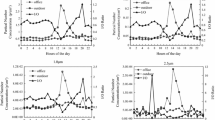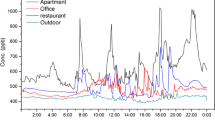Abstract
At present, indoor particulate matter pollution is a widespread concern because particulate matter is one of the main indoor pollutants affecting human health. However, few studies have focused on correlation between outside and inside particle sources. The experiment of this study was conducted in an office in Qingdao, China. The particle size distribution ranged from 0.3 to 2.5 μm, and the collection time was from April 2019 to January 2020. The results showed that the particle concentration was largest in winter and smallest in summer. Based on the balance of particle mass equation and the measured data of I/O (indoor and outdoor particle concentration ratio), the outside and indoor source emissions were obtained, respectively. The data showed that the indoor emission was largest in winter and smallest in summer, accounting for particulate proportions of 60–65% and 10–22%, respectively. It indicates that indoor emissions are strongly correlated with the outdoors pollution level. Therefore, the trajectories of air mass were simulated for each measurement season to track the long-range transport pathways of outdoor airflow arriving at the sampling site. The results gave the useful information about pollution contributions from any possible sources, such as from the local regional sources, from trans-regional sources as well as from oceanic sources. The investigation of this study is conducive to make appropriate strategies and take effective measures on indoor particle pollution control.






Similar content being viewed by others
Data availability
The datasets generated and analyzed during the current study are available in the [ftp://arlftp.arlhq.noaa.gov/pub/archives/gdas1] repository, [PERSISTENT WEB LINK TO DATASETS].
References
Almeida SM, Canha N, Silva A, Freitas MC, Pegas P, Alves C, Evtyugina M, Pio CA (2011) Children exposure to atmospheric particles in indoor of Lisbon primary schools. Atmos Environ 45:7594–7599
Blondeau P, Iordache V, Poupard O, Genin D, Allard F (2005) Relationship between outdoor and indoor air quality in eight French schools. Indoor Air 15:2–12
Cong XC, Zhao JJ, Jing Z, Wang QG, Ni PF (2018) Indoor particle dynamics in a school office: determination of particle concentrations, deposition rates and penetration factors under naturally ventilated conditions. Environ Geochem Health 40(6):2511–2524
Diette GB, Hansel NN, Buckley TJ, Curtin-Brosnan J, Eggleston PA, Matsui EC, McCormack MC, Williams DAL, Breysse PN (2007) Home indoor pollutant exposures among inner-city children with and without asthma. Environ Health Perspect 115:1665
Elbayoumi M, Ramli NA, Yusof NFM, Madhoun WA (2013) Spatial and seasonal variation of particulate matter (PM10 and PM2.5) in Middle Eastern classrooms. Atmos Environ 80:389–397
Fromme H, Diemer J, Dietrich S, Cyrys J, Heinrich J, Lang W, Kiranoglu M, Twardella D (2008) Chemical and morphological properties of particulate matter (PM10, PM2.5) in school classrooms and outdoor air. Atmos Environ 42:6597–6605
Gemenetzis P (2006) Mass concentration and elemental composition of indoor PM2.5 and PM10 in University rooms in Thessaloniki, northern Greece. Atmos Environ 40:3195–3206
Goyal R, Khare M (2009) Indoor-outdoor concentrations of RSPM in classroom of a naturally ventilated school building near an urban traffic roadway. Atmos Environ 43:6026–6038
Goyal R, Khare M (2011) Indoor air quality modeling for PM10, PM2.5, and PM1.0 in naturally ventilated classrooms of an urban Indian school building. Environ Monit Assess 176:501–516
Habil M, Taneja A (2011) Children’s exposure to indoor particulate matter in naturally ventilated schools in India. Indoor Built Environ 20:430–448
Hussein T, Puustinen A, Aalto PP, Mäkelä JM, Hämeri K, Kulmala M (2004) Urban aerosol number size distributions. Atmos Chem Phys 4:391–411
Jorba O, Pérez C, Rocadenbosch F, Baldasano JM (2004) Cluster analysis of 4-day back trajectories arriving in the Barcelona area, Spain, from 1997 to 2002. J Appl Meteorol 43:887–901
Kang H, Zhu B, Su J, Wang H, Zhang Q, Wang F (2013) Analysis of a long-lasting haze episode in Nanjing, China[J]. Atmos Res 120–121:78–87
Karaca F, Anil I, Alagha O (2009) Long-range potential source contributions of episodic aerosol events to PM 10 profile of a megacity. Atmos Environ 43(36):5713–5722
Kukkonen J, Pohjola M, Sokhi RS, Luhana L, Kitwiroon N, Rantamäki M, Berge E, Odegaard V, Slørdal LH, Denby B, Finardi S (2005) Analysis and evaluation of localscale PM10 air pollution episodes in four European cities: Helsinki, London, Milan and Oslo. Atmos Environ 39(15):2759–2773
Lai CKA, Fung JLS, Leung KY (2012) Penetration of fine particles through rough cracks. Atmos Environ 60:436–443
Pohjola MA, Rantamäki M, Kukkonen J, Karppinen A, Berge E (2004) Meteorological evaluation of a severe air pollution episode in Helsinki on 27–29 December 1995. Boreal Environ Res 9(1):75–87
Polidori A, Cheung KL, Arhami M, Delfino RJ, Schauer JJ, Sioutas C (2009) Relationships between size-fractionated indoor and outdoor trace elements at four retirement communities in southern California. Atmos Chem Phys 9:4521–4536
Polissar AV, Hopke PK, Poirot RL (2001) Atmospheric Aerosol Over Vermont: chemical composition and sources. Environ Sci Technol 135:4604–4621
Salvador P, Artíñano B, Querol X, Alastuey A (2007) A combined analysis of backward trajectories and aerosol chemistry to characterise long-range transport episodes of particulate matter: The Madrid air basin, a case study. Sci Total Environ 390(2):495–506
Saraga D, Maggos T, Sfetsos A, Tolis E, Andronopoulos S, Bartzis J, Vasilakos C (2010) PAHs sources contribution to the air quality of an office environment: experimental results and receptor model (PMF) application. Air Qual Atmos Health 3:225–234
Shaeb KH, Rao KK, Althaf P et al (2020) Seasonal characteristics of black carbon aerosols over an urban city in India: source analysis using concentration weighted trajectories. Asia-Pac J Atmos Sci 56(1):29–43
Shao JY (2020) Lidar observation of aerosols in boundary layer and free troposphere at Wuhan, China. Wuhan university, Wuhan
Singer BC, Hodgson AT, Hotchi T, Kim JJ (2004) Passive measurement of nitrogen oxides to assess traffic-related pollutant exposure for the East Bay Children’s Respiratory Health Study. Atmos Environ 38:393–403
Tian L, Zhang G, Jinghua T, Zhou J, Zhang Q (2009) Mathematical model of particle penetration through smooth/rough building envelop leakages. Build Environ 44:1144–1149
Wang F, Chen D, Cheng S, Li M (2009a) Air pollution transport impact based on air flow trajectory clustering. Environ Sci Res 22(06):637–642
Wang Y, Zhang X, Draxler RR (2009b) TrajStat: GIS-based software that uses various trajectory statistical analysis methods to identify potential sources from long-term air pollution measurement data. Environ Model Soft 24:938–939
Wang L, Liu Z, Sun Y, Ji D, Wang Y (2015) Long-range transport and regional sources of PM 2.5 in Beijing based on long-term observations from 2005 to 2010[J]. Atmos Res 157:37–48
Wang Z, Wu T, Shi G et al (2016) Potential source analysis for PM10 and PM2.5 in autumn in a northern city in China. Aerosol Air Qual Res 12(1):39–48
WHO (2011) Methods for Monitoring Indoor Air Quality in Schools. World Health Organization, WHO Regional Publications, Bonn (European Series)
Xue W, Fu F, Wang J, Tang G, Lei Y, Yang J (2014) Wang yuesi. China PM(2.5) numerical simulation of cross regional transport characteristics. China Environ Sci 34(06):1361–1368
Zock J, Jarvis D, Luczynska C, Sunyer J, Burney P (2002) Housing characteristics, reported mold exposure, and asthma in the European Community Respiratory Health Survey. J Allergy Clin Immunol 110:285–292
Funding
This study was supported by the oversea study foundation of Shandong provincial government in 2019.
Author information
Authors and Affiliations
Corresponding author
Ethics declarations
Ethics approval and consent to participate
The authors are all in ethics approval for this paper and consent to participate.
Consent for publication
The authors all consent for publication.
Competing interests
The authors declare no competing interest.
Additional information
Publisher's note
Springer Nature remains neutral with regard to jurisdictional claims in published maps and institutional affiliations.
Supplementary Information
Below is the link to the electronic supplementary material.
Rights and permissions
About this article
Cite this article
Ding, H., Gao, H., Wang, C. et al. Seasonal variations of particle number distribution in an office environment and outside potential pollution sources. Air Qual Atmos Health 15, 739–748 (2022). https://doi.org/10.1007/s11869-022-01172-5
Received:
Accepted:
Published:
Issue Date:
DOI: https://doi.org/10.1007/s11869-022-01172-5




